 |
| Flavors that Endure: The Preservation of Vegetables and Tradition in Taitung |
|
Taitung is celebrated for its rich natural resources—fertile lands, diverse ecosystems, and abundant marine life. Yet throughout history, its people have faced the unpredictability of natural disasters, including devastating typhoons and earthquakes, as well as intertribal conflicts, waves of immigration, and colonialism. The region's sparse population and remote location have also made it vulnerable to supply disruptions. These conditions paved the way for the emergence of distinctive preservation methods, which have enhanced local flavors over time while reflecting the region’s culture, history, and environment. In this series, we will explore the salting, pickling, fermenting, smoking and drying of staple meat, fish, fruits and vegetables, grains and teas. These processes transformed perishable ingredients into preserved delicacies while telling a broader story about the resilience, resourcefulness and creativity of Taitungers. Following on from the preservation of meat, this edition explores the roots and spread of vegetable pickling, fermentation and drying techniques over time in Taitung. EASTERN DRIFT, HAKKA RIFT
The townships of the East Rift Valley are a cultural melting pot, home to a significant Hakka population in Chishang, Guanshan, and Luye, with Bunun Indigenous villages on the outskirts in Yanping and Haiduan. Historically, the Hakka have been a migratory people, fleeing and reestablishing themselves in new lands as they fled political upheaval and persecution in Northern and Central China and, later on, also in search of better farmland and economic opportunities. Taitung, formerly known as “behind the mountains” (houshan), and the Rift Valley in particular, provided the pristine land and relatively isolated location they sought. The Chinese characters for Hakka (客家) mean "guest people," reflecting their history of displacement as they moved across China and beyond. This generational instability and migratory existence often led to stereotypes, such as being "stingy" or suspicious of outsiders. However, these very circumstances fostered a culture of thriftiness, resourcefulness and resilience, to survive amidst rapidly changing conditions, as demonstrated through their waste minimization and food preservation techniques. Their need for sustenance during uncertain times led to the growth of pickling, fermenting, and sun or air-drying techniques to extend the shelf life of vegetables and meats. Salt, vinegar, sugar, oil, alcohol and microorganisms played essential roles in preserving food for long journeys and seasonal scarcity. GREENS FOR ALL SEASONS
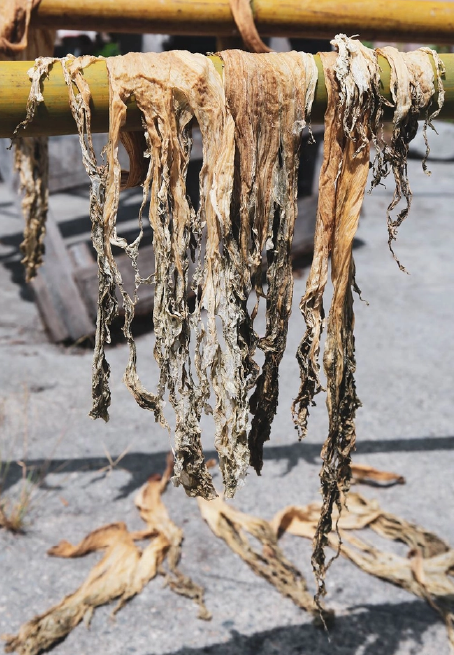 As the Hakka settled in Taitung’s East Rift Valley, they brought with them their culinary traditions, which continue to thrive today. Numerous eateries maintain the flavors of Hakka cuisine while incorporating local ingredients. One such establishment is Mama Huang’s Hakka Kitchen in Guanshan, which showcases how Hakka vegetable preservation has become interwoven into Taitung’s culinary landscape. Mustard greens (jiecai), a staple in Hakka fermentation, illustrate the depth and variety of flavors achievable through different preservation methods. Planted right after the second rice harvest, mustard greens make thrifty use of the temporary surplus of field space and are ready for harvest within 60 days. The leftover greens are salted and packed into jars to ferment in their own juices for two weeks where they transform into xiancai (鹹菜)—a salted, tangy, sour metamorphosis, ideal for stir-frying with meats. Further drying the leftovers under the Taitung sun until only 20% of their water remains, followed by another 4-6 months of fermentation in bottles stored at room temperature, yields the drier fucai (福菜), a deeply umami-rich ingredient for soups and stews. Mama Huang’s signature Fucai and Bitter Gourd Pork Bone Soup (福菜苦瓜排骨湯) is a testament to this tradition.  Finally, the leftovers of the same batch of mustard greens can be sun-dried once again to fully dehydrate the leaves, turning them into meigancai (梅乾菜), dark, dry and bursting with flavour—perfect for traditional Hakka dishes. Each stage of preservation transforms the flavors, offering endless variations to their favourite dishes. From fresh greens to fermented flavors, each bite tells a story of time, patience, and tradition. Other vegetables, such as cabbage, undergo similar stages of sun-drying and fermentation. Mama Huang sun-dries cabbage to develop lactic acid as it ferments, yielding tangy cabbage shreds, which she uses for another signature dish: Braised Pork Belly with Sun-Dried Cabbage (高麗菜乾扣肉). Different levels of preservation bring unique nuances to Hakka cuisine. ROOTED IN TRADITION: THE GUANSHAN RADISH
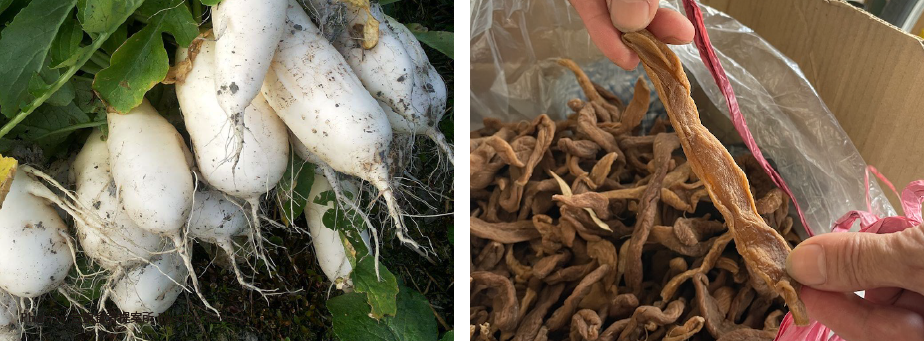 The East Rift Valley also produces elongated varieties of radish—white jade (baiyu 白玉),golden (jinjiao 金筊) and plum blossom (meihua 梅花), which thrive on the mild winters, abundant rainfall and nutrient-rich soil in the area. At the annual Guanshan Radish Festival held in January, visitors can pick their own fresh radishes and even learn how to pickle them on-site. These radishes are often cut into strips (for greater sunlight penetration) and sun-dried over several days into dried shreds. The radish can also be further fermented into Hakka-style preserved radish (caipu 菜脯), which can be add a delightful crunch and savory-flavour to dishes like radish omelette or served with rice porridge for a traditional Hakka breakfast. While the dried radish shreds can last up to a year without spoiling, the fermented radish can be stored indefinitely. This provides a richly-flavoured store of resilience at only a fraction of the weight. If pickling leafy vegetables is meant to extend their shelf life, then pickling radishes serves to consume and distribute surplus harvests. Furthermore, any unused radishes can remain as compost in the soil from whence it came. A cycle rooted in the land and tradition 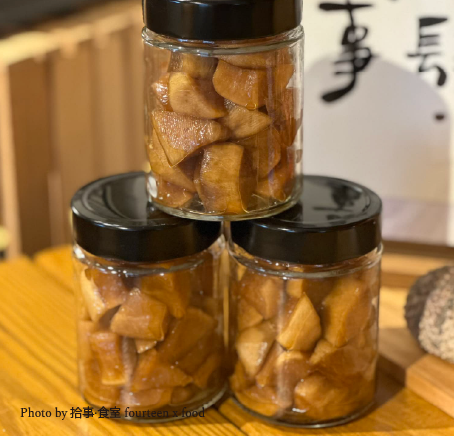 Inspired by the Slow Food movement being promoted in Taitung County, emerging Slow Food startups experiment with preservation techniques and in the process offer solutions to small farmers facing the challenges of fluctuating agricultural yields and extreme weather. For example, Minokay, a young food startup in Donghe Township, pickles leftover radishes from a farm in Pinaski Tribal Village immediately after harvest with their own secret recipe sauce for later sale in local communities, reducing food waste and supporting local farmers. JARS OF WISDOM AND FLAVOR
Safe access to the mountains has always been dependent on weather conditions, therefore long before refrigeration, Indigenous communities in Taitung preserved wild vegetables foraged from the mountains to ensure food security. Large earthenware jars that have existed in this region since prehistoric times were often used to salt and ferment vegetables, to be saved for a rainy or typhoon day, though it’s now more common to use glass jars. The knowledge of preparation, including precise amounts of salt and pickling techniques, remains deeply rooted in the elder generation. To this day, these jars are seen as miniature refrigerators all over the house, always within reach. 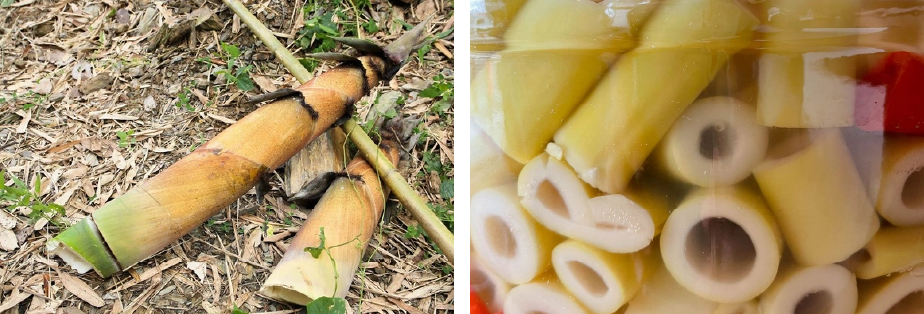 The Amis people are said to recognize over 200 types of wild plants on sight, which makes them expert foragers of naturally growing foods. One of their favorites is the spiny bamboo shoot, which grows abundantly and is ready for harvest each June. After stripping away the outer shell, they use the soft top section for soups, while the crunchy middle section is set aside for pickling (and the harder bottom section discarded). The shoots are boiled, cooled, salted, and combined with the maker's favourite ingredients and rice wine before being sealed in jars with the leftover cooking water. Over time, fermentation transforms them into Fukah (酸筍), or pickled bamboo shoots, which make a crisp, tangy accompaniment to stir-fries and seafood dishes. Today, jars of Fukah can still be found alongside siraw (salted pork) at Indigenous street stands along the East Coast and local initiatives live the ‘Etolan Style’ community market in Dulan. In the Bunun village of Kanding, Haiduan Township, the Kaiana Workshop, a Slow Food restaurant, is helping to revive traditional Indigenous ingredients through fusion cuisine. One of their signature dishes combines pickled bamboo shoots with slow-braised pork—a flavorful blend of Indigenous and Han culinary traditions. 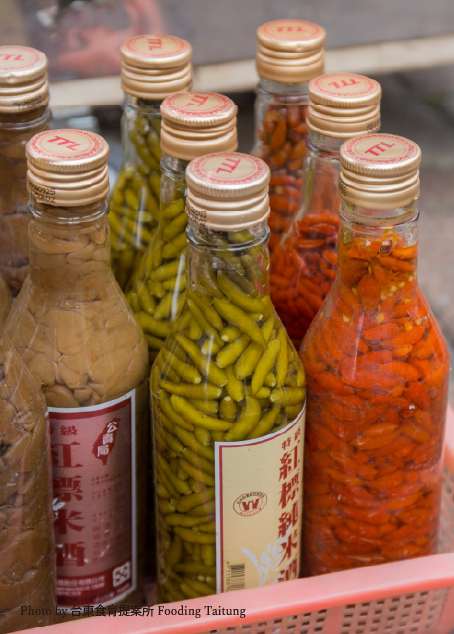 Throughout Indigenous communities on the east coast, there are also jars bursting with flavors to be used as condiments, appetizers or drinking accompaniments. One will find small rice wine bottles packed with red (ripe) or green (unripe) chicken-heart chillis (醃雞心椒), known as such for their shape. Though tiny, these chilis can be pickled directly in the rice wine with salt, and pack a spicy punch that is sweat-inducing and improves circulation, while the milder and larger green peeled chili peppers (剝皮辣椒) can still pique the appetite without upsetting weaker stomachs. Another popular condiment locally grown in the East Rift Valley is rakkyo (蕗蕎), a bulbous onion variety, commonly salted, sweetened, and pickled in white vinegar offering a rare, crunchy addition to indigenous cuisine. PRESERVING FOOD AND TRADITION IN TAITUNG
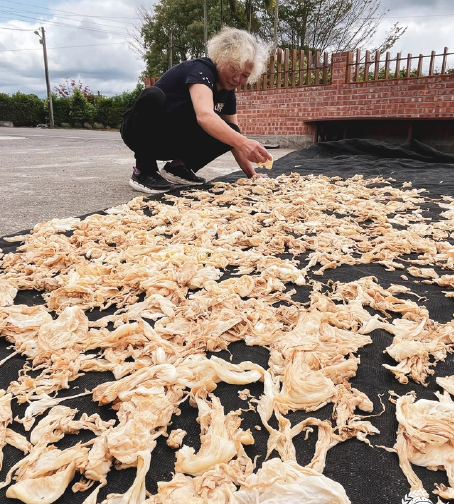 With the advent of modern refrigeration, much of the knowledge of pickling, fermenting and drying was at risk of being lost to younger generations. However, even today, when food preservation and distribution is remarkably convenient, these traditional methods have kept alive techniques and culture that enhance the flavours of local cuisine. In recent years, with Taitung County proactively pushing the Slow Food movement and Indigenous food cultures, there has been renewed pride in traditional culinary practices among younger generations—preserving not only the foods but the cultural wisdom of their elders, passed down through generations. Yet, for coastal and island communities in Taitung, preservation wasn’t limited to land resources, fishing and foraging the ocean floor for shellfish have long been essential sources of protein. Sustainable fishing and intertidal foraging practices were crucial to maintaining these resources for future generations and ocean fishing has always been notoriously dangerous, so how did coastal communities ensure their hard-earned marine protein lasted through the seasons? In the next edition of Taitung Times, we will discover how the Tao of Orchid Island relied on the Pacific winds to cure their prized flying fish and other traditions of seafood preservation in Taitung. |
| © TAITUNG COUNTY GOVERNMENT 2025 |




